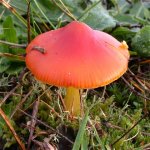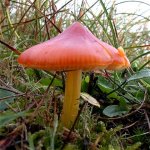brianhstone said:
Is this Hygrocybe conicoides or conica please?
I should add this was photographed in sand dunes on the NW Norfolk coast at the weekend.
Tricky! If it is either of the two, then it is too young and fresh to be showing the characteristic blackening.
I am sure it isn't
H. conica, in the strict sense, and while the shape is more correct for
H. conicoides, the colour is rather bright.
H. conicoides is typically a more cherry red, and also a little more sturdy.
My guess, and this is only a guess, is that this is the dune form of
Hygrocybe persistens (which, as I have said in another post, I think is a distinct species). It is much more orange than typical
H. persistens, and also differs in its spores. Indeed a very attractive toadstool!
I personally know it on the East Lothian dunes, but it seems to occur widely round the east and south coasts.
Nice photos, but in this case, just a little too nice. If only there was an old, manky one in shot!
Alan





